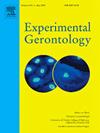老年化和晚年死亡率的压缩
IF 4.3
3区 医学
Q2 GERIATRICS & GERONTOLOGY
引用次数: 7
摘要
衰老细胞在哺乳动物衰老和年龄相关疾病的病因学中起着重要作用。用抗衰老药(一种选择性去除衰老细胞的药物)治疗小鼠,可以延长小鼠的中位寿命,但对最大寿命几乎没有影响。将某些死亡率推迟到较晚的年龄,而最高死亡率没有相应增加,可称为“死亡率压缩”。当我们将标准Gompertz死亡率模型拟合到老年治疗后的生存数据时,我们发现斜率参数增加,通常被描述为“精算老化率”。这些观察结果提出了关于抗衰老治疗的作用及其对健康和生存的影响的重要问题,这些问题尚未得到充分的了解。为了探索如何解释衰老实验的生存数据,我们将最近对细胞衰老的进化基础的探索与可能涉及的分子过程的理论考虑结合起来。我们执行衰老细胞积累和衰老治疗在老龄化人口的数值模拟。模拟表明,虽然衰老药物减轻了衰老细胞的负担,但它们也可能损害生物体的一般修复能力,导致新的衰老细胞在处理后更快地积累。我们的研究结果提出了一个框架来解决衰老治疗的益处和可能的副作用,有可能帮助设计最佳治疗方案。本文章由计算机程序翻译,如有差异,请以英文原文为准。
Senolytics and the compression of late-life mortality
Senescent cells play an important role in mammalian ageing and in the etiology of age-related diseases. Treatment of mice with senolytics – drugs that selectively remove senescent cells – causes an extension of median lifespan but has little effect on maximum lifespan. Postponement of some mortality to later ages, without a corresponding increase in maximum mortality, can be termed ‘compression of mortality’. When we fit the standard Gompertz mortality model to the survival data following senolytic treatment, we find an increase in the slope parameter, commonly described as the ‘actuarial ageing rate’. These observations raise important questions about the actions of senolytic treatments and their effects on health and survival, which are not yet sufficiently understood. To explore how the survival data from senolytics experiments might be explained, we combine recent exploration of the evolutionary basis of cellular senescence with theoretical consideration of the molecular processes that might be involved. We perform numerical simulations of senescent cell accumulation and senolytic treatment in an ageing population. The simulations suggest that while senolytics diminish the burden of senescent cells, they may also impair the general repair capacity of the organism, leading to a faster accumulation post-treatment of new senescent cells. Our results suggest a framework to address the benefits and possible side effects of senolytic therapies, with the potential to aid the design of optimal treatment regimens.
求助全文
通过发布文献求助,成功后即可免费获取论文全文。
去求助
来源期刊

Experimental Gerontology
医学-老年医学
CiteScore
7.30
自引率
2.60%
发文量
280
审稿时长
1 months
期刊介绍:
Experimental Gerontology is a multidisciplinary journal for the publication of work from all areas of biogerontology, with an emphasis on studies focused at the systems level of investigation, such as whole organisms (e.g. invertebrate genetic models), immune, endocrine and cellular systems, as well as whole population studies (e.g. epidemiology).
The journal also publishes studies into the behavioural and cognitive consequences of aging, where a clear biological causal link is implicated. Studies aimed at bridging the gap between basic and clinical aspects of gerontology, such as papers on the basic aspects of age-related diseases, are welcomed, as is research orientated toward the modulation of the aging process. Original research manuscripts, special issues, short reports, reviews, mini-reviews, and correspondence are published. Manuscripts on social aspects of aging and reports on clinical studies do not fall within the scope of the journal.
 求助内容:
求助内容: 应助结果提醒方式:
应助结果提醒方式:


